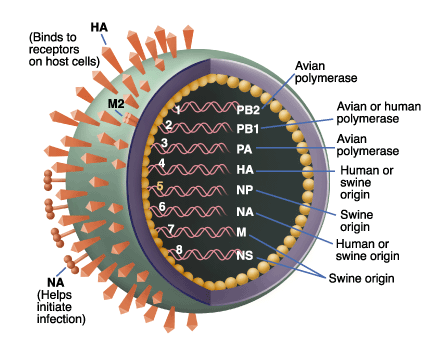 There has been so much panic spreading across the globe since the discovery of Swine Flu Infecting a group of school kids returning from their trip to Mexico last week. Based on my own personal understanding Swine flu has been around and is quite treatable. The cause of panic though is due to the main fact that people that got infected by this disease has a chance of death if not treated at its early stage, aside from that many cant tell the difference between a regular flu versus that of Swine flu. In today's Wellness Wednesday Article am going to feature two main things: What is Swine Flu and How to Prevent it.
There has been so much panic spreading across the globe since the discovery of Swine Flu Infecting a group of school kids returning from their trip to Mexico last week. Based on my own personal understanding Swine flu has been around and is quite treatable. The cause of panic though is due to the main fact that people that got infected by this disease has a chance of death if not treated at its early stage, aside from that many cant tell the difference between a regular flu versus that of Swine flu. In today's Wellness Wednesday Article am going to feature two main things: What is Swine Flu and How to Prevent it.Like always, I let my fingers do the walking to check out what the virtual streets have to say about this disease and here are the things that I have found.
What is Swine Flu:
Swine Influenza (swine flu) is a respiratory disease of pigs caused by type A influenza virus that regularly causes outbreaks of influenza in pigs. Swine flu viruses cause high levels of illness and low death rates in pigs. Swine influenza viruses may circulate among swine throughout the year, but most outbreaks occur during the late fall and winter months similar to outbreaks in humans. The classical swine flu virus (an influenza type A H1N1 virus) was first isolated from a pig in 1930.
How many swine flu viruses are there?
Like all influenza viruses, swine flu viruses change constantly. Pigs can be infected by avian influenza and human influenza viruses as well as swine influenza viruses. When influenza viruses from different species infect pigs, the viruses can reassort (i.e. swap genes) and new viruses that are a mix of swine, human and/or avian influenza viruses can emerge. Over the years, different variations of swine flu viruses have emerged. At this time, there are four main influenza type A virus subtypes that have been isolated in pigs: H1N1, H1N2, H3N2, and H3N1. However, most of the recently isolated influenza viruses from pigs have been H1N1 viruses.
Swine Flu in Humans
Swine flu viruses do not normally infect humans. However, sporadic human infections with swine flu have occurred. Most commonly, these cases occur in persons with direct exposure to pigs (e.g. children near pigs at a fair or workers in the swine industry). In addition, there have been documented cases of one person spreading swine flu to others. For example, an outbreak of apparent swine flu infection in pigs in Wisconsin in 1988 resulted in multiple human infections, and, although no community outbreak resulted, there was antibody evidence of virus transmission from the patient to health care workers who had close contact with the patient.
How common is swine flu infection in humans?
In the past, CDC received reports of approximately one human swine influenza virus infection every one to two years in the U.S., but from December 2005 through February 2009, 12 cases of human infection with swine influenza have been reported.
What are the symptoms of swine flu in humans?
The symptoms of swine flu in people are expected to be similar to the symptoms of regular human seasonal influenza and include fever, lethargy, lack of appetite and coughing. Some people with swine flu also have reported runny nose, sore throat, nausea, vomiting and diarrhea.
Can people catch swine flu from eating pork?
No. Swine influenza viruses are not transmitted by food. You can not get swine influenza from eating pork or pork products. Eating properly handled and cooked pork and pork products is safe. Cooking pork to an internal temperature of 160°F kills the swine flu virus as it does other bacteria and viruses.
How to Prevent it:
There are everyday actions people can take to stay healthy.
- Cover your nose and mouth with a tissue when you cough or sneeze. Throw the tissue in the trash after you use it.
- Wash your hands often with soap and water, especially after you cough or sneeze. Alcohol-based hands cleaners are also effective.
- Avoid touching your eyes, nose or mouth. Germs spread that way.
Try to avoid close contact with sick people.
- Influenza is thought to spread mainly person-to-person through coughing or sneezing of infected people.
- If you get sick, CDC recommends that you stay home from work or school and limit contact with others to keep from infecting them.
I do hope that this article helps shed some light to those that are wondering about this particular disease that has just recently caused a world wide panic. - All the data you have seen here is in reference with the information found with the CDC about Swine Flu - Please pay a visit to their website for updates on the threat that the Swine Flu has as of now with the General Population. For those affected by this terrible affliction my prayers are with all of you.


No comments:
Post a Comment